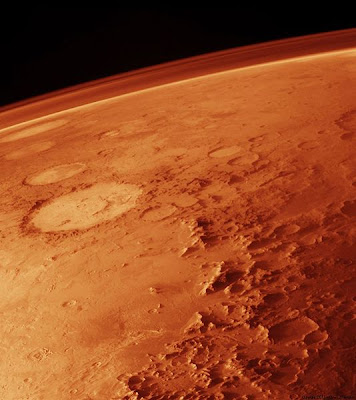Mars lost its magnetosphere 4 billion years ago, so the solar wind interacts directly with the Martian ionosphere, keeping the atmosphere thinner than it would otherwise be by stripping away atoms from the outer layer. Both Mars Global Surveyor and Mars Express have detected these ionised atmospheric particles trailing off into space behind Mars.[52][53] The atmosphere of Mars is now relatively thin. Atmospheric pressure on the surface varies from around 30 Pa (0.03 kPa) on Olympus Mons to over 1,155 Pa (1.155 kPa) in the depths of Hellas Planitia, with a mean surface level pressure of 600 Pa (0.6 kPa). Mars's mean surface pressure equals the pressure found 35 km above the Earth's surface. This is less than 1% of the surface pressure on Earth (101.3 kPa). The scale height of the atmosphere, about 11 km, is higher than Earth's (6 km) due to the lower gravity. Mars' gravity is only about 38% of the surface gravity on Earth.
The atmosphere on Mars consists of 95% carbon dioxide, 3% nitrogen, 1.6% argon, and contains traces of oxygen and water.[5] The atmosphere is quite dusty, containing particulates about 1.5 µm in diameter which give the Martian sky a tawny color when seen from the surface.[54]
Traces of methane plumes in Mars’ atmosphere during northern summer - NASA
Several researchers claim to have detected methane in the Martian atmosphere with a concentration of about 30 ppb by volume.[55][56] Since methane is an unstable gas that is broken down by ultraviolet radiation, typically lasting about 340 years in the Martian atmosphere,[57] its presence would indicate a current or recent source of the gas on the planet. Volcanic activity, cometary impacts, and the presence of methanogenic microbial life forms are among possible sources. It was recently pointed out that methane could also be produced by a non-biological process called serpentinization[b] involving water, carbon dioxide, and the mineral olivine, which is known to be common on Mars.[58]
During a pole's winter, it lies in continuous darkness, chilling the surface and causing 25–30% of the atmosphere to condense out into thick slabs of CO2 ice (dry ice).[59] When the poles are again exposed to sunlight, the frozen CO2 sublimes, creating enormous winds that sweep off the poles as fast as 400 km/h. These seasonal actions transport large amounts of dust and water vapor, giving rise to Earth-like frost and large cirrus clouds. Clouds of water-ice were photographed by the Opportunity rover in 2004.[60]

0 comments
Post a Comment